
Home - Search - Browse - Alphabetic Index: 0- 1- 2- 3- 4- 5- 6- 7- 8- 9
A- B- C- D- E- F- G- H- I- J- K- L- M- N- O- P- Q- R- S- T- U- V- W- X- Y- Z
STS-51-D
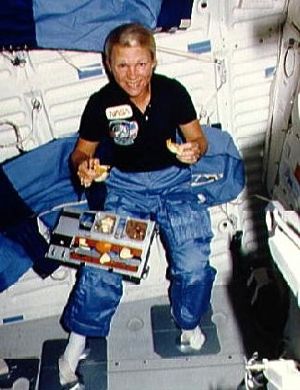 STS-51-D Astronaut Rhea Seddon sits down to a meal in the middeck Credit: NASA |
AKA: Discovery. Launched: 1985-04-12. Returned: 1985-04-19. Number crew: 7 . Duration: 7.00 days.
Payloads: Telesat (Canada communications satellite)-I with Payload Assist Module (PAM)-D deployment, Syncom IV-3 communications satellite deployment with its unique stage (unique stage failed to ignite), Continuous Flow Electrophoresis (CFES), Phase Partitioning Experiment (PPE), student experiments, two getaway specials (GAS) Informal science studies (Toys in Space).
Orbits of Earth: 109. Distance traveled: 4,650,658 km. Orbiter Liftoff Mass: 113,802 kg. Orbiter Mass at Landing: 89,816 kg. Payload to Orbit: 16,249 kg. Payload Returned: 6,009 kg. Landed at: Runway 33 at Kennedy Space Center, Florida. Landing Speed: 370 kph. Touchdown miss distance: 499 m. Landing Rollout: 3,179 m. EVA: Jeffrey Hoffman and David Griggs, duration, 3 hours, 10 minutes.
NASA Official Mission Narrative
Mission Name: 51-D (16)
DISCOVERY (4)
Pad 39-A (28)
16th Shuttle mission
4th Flight OV-103
Extended mission
5th KSC landing
Crew:
Karol J. Bobko (2), Commander
Donald E. Williams (1), Pilot
M. Rhea Seddon (1), Mission Specialist 1
Jeffrey A. Hoffman (1), Mission Specialist 2
S. David Griggs (1), Mission Specialist 3
Charles D. Walker (2), Payload Specialist 1
Sen E. Jake Garn (1), Payload Specialist 2
Milestones:
OPF - Jan. 28, 1985
VAB - March 23,1985
PAD - March 28, 1985
Payload:
LEASAT-3,ANIK-E2,CFES(6),AFE,PPE/SAS,SSIP(x2),GAS(x2)
Mission Objectives:
Launch:
April 12, 1985, 8:59:05 a.m. EST. Launch set for March 19 rescheduled to March 28 due to remanifesting of payloads from canceled mission 51-E. Delayed further due to damage to orbiter's payload bay door when facility access platform dropped. Launch April 12 delayed 55 minutes when ship entered restricted solid rocket booster recovery area. Launch Weight: 250,891 lbs.
Orbit:
Altitude: 285nm
Inclination: 28.5 degrees
Orbits: 110
Duration: Six days, 23 hours, 55 minutes, 23 seconds.
Distance: 2,889,785 miles
Hardware:
SRB: BI-018
SRM: L017(HPM)
ET : 18/LWT-11
MLP : 1
SSME-1: SN-2109
SSME-2: SN-2018
SSME-3: SN-2012
Landing:
April 19, 1985,8:54:28 a.m. EST, Runway 33, Kennedy Space Center, Fla. Rollout distance: 10,430 feet. Rollout time: 63 seconds. Extensive brake damage and blown tire during landing prompted landing of future flights at Edwards Air Force Base until implementation of nose wheel steering. Landing Weight: 198,014 lbs.
Mission Highlights:
TELESAT-l (ANIK C-1) communications satellite deployed, attached to Payload Assist Module (PAM-D) motor. SYNCOM IV-3 (also known as LEASAT-3) deployed. But spacecraft sequencer failed to initiate antenna deployment, spin.up and ignition of perigee kick motor. Mission extended two days to make certain sequencer start lever in proper position. Griggs and Hoffman performed space walk to attach Flyswatter devices to remote manipulator system. Seddon engaged LEASAT lever using remote manipulator system but post deployment sequence did not begin. Other payloads: Continuous Flow Electrophoresis System (CFES) III, flying for sixth time; two Shuttle Student Involvement Program (SSIP) experiments; American Flight Echocardiograph (AFE); two Get Away Specials; Phase Partitioning Experiments (PPE); astronomy Photography verification test; medical experiments and `toys in space, an informal study of the behavior of simple toys in weightless environment, with results to be made available to school students.
More at: STS-51-D.
Family: Manned spaceflight. People: Bobko, Garn, Griggs, Hoffman, Seddon, Walker, Williams, Donald. Country: USA. Spacecraft: Discovery. Projects: STS. Launch Sites: Cape Canaveral. Agency: NASA, NASA Houston.
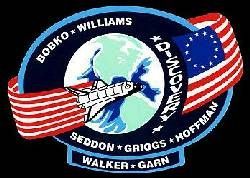 | STS-51-D Credit: www.spacefacts.de |
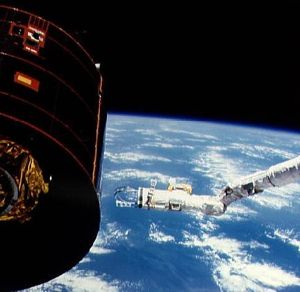 | STS-51-D End effector of the Discovery's RMS with tools moves toward Syncom-IV Credit: NASA |
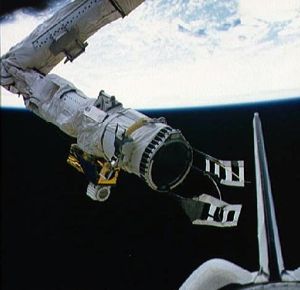 | STS-51-D End effector of the Discovery's RMS with tools attached Credit: NASA |
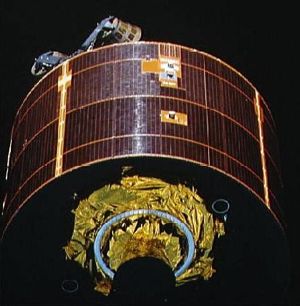 | STS-51-D Syncom-IV (LEASAT) satellite Credit: NASA |
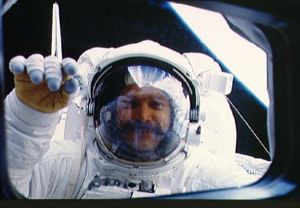 | STS-51-D Astronaut S. David Griggs waves to Orbiter during EVA Credit: NASA |
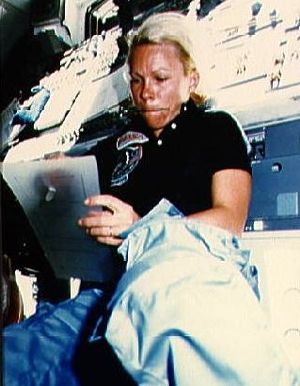 | STS-51-D Astronaut Rhea Seddon works on flyswatter-like snagging device Credit: NASA |
1984 April 16 - .
- STS-51-D - Wakeup Song: Top of the World - . Flight: STS-51-D. "Top of the World" by The Carpenters.
1984 April 17 - .
- STS-51-D - Wakeup Song: Rescue Aid Society - . Flight: STS-51-D. "Rescue Aid Society" from the Disney film,"The Rescuers"..
1985 April 12 - . 13:59 GMT - . Launch Site: Cape Canaveral. Launch Complex: Cape Canaveral LC39A. Launch Platform: MLP1. LV Family: Shuttle. Launch Vehicle: Space Shuttle.
- STS-51-D - .
Call Sign: Discovery. Crew: Bobko,
Garn,
Griggs,
Hoffman,
Seddon,
Walker,
Williams, Donald.
Payload: Discovery F04 / Anik C1[PAM-D] / Syncom-4 3 /Orbus. Mass: 16,249 kg (35,822 lb). Nation: USA.
Related Persons: Bobko,
Garn,
Griggs,
Hoffman,
Seddon,
Walker,
Williams, Donald.
Agency: NASA Houston.
Program: STS.
Class: Manned.
Type: Manned spaceplane. Flight: STS-51-D.
Spacecraft Bus: Shuttle.
Spacecraft: Discovery.
Duration: 7.00 days. Decay Date: 1985-04-19 . USAF Sat Cat: 15641 . COSPAR: 1985-028A. Apogee: 535 km (332 mi). Perigee: 445 km (276 mi). Inclination: 28.50 deg. Period: 94.40 min.
Manned seven crew. Payloads: Telesat (Canada communications satellite)-I with Payload Assist Module (PAM)-D deployment, Syncom IV-3 communications satellite deploy-ment with its unique stage (unique stage failed to ignite), Continuous Flow Electrophoresis (CFES), Phase Partitioning Experiment (PPE), student experiments, two getaway specials (GAS) Informal science studies (Toys in Space).
1985 April 16 - .
- EVA STS-51-D-1 - . Crew: Griggs, Hoffman. EVA Duration: 0.13 days. Nation: USA. Related Persons: Griggs, Hoffman. Program: STS. Class: Manned. Type: Manned spaceplane. Flight: STS-51-D. Spacecraft Bus: Shuttle. Spacecraft: Discovery. RMS 'Ryswatters' installed..
1985 April 19 - .
- Landing of STS-51-D - . Return Crew: Bobko, Garn, Griggs, Hoffman, Seddon, Walker, Williams, Donald. Nation: USA. Related Persons: Bobko, Garn, Griggs, Hoffman, Seddon, Walker, Williams, Donald. Program: STS. Flight: STS-51-D. STS-51-D landed at 13:50 GMT. .
Back to top of page
Home - Search - Browse - Alphabetic Index: 0- 1- 2- 3- 4- 5- 6- 7- 8- 9
A- B- C- D- E- F- G- H- I- J- K- L- M- N- O- P- Q- R- S- T- U- V- W- X- Y- Z
© 1997-2019 Mark Wade - Contact
© / Conditions for Use